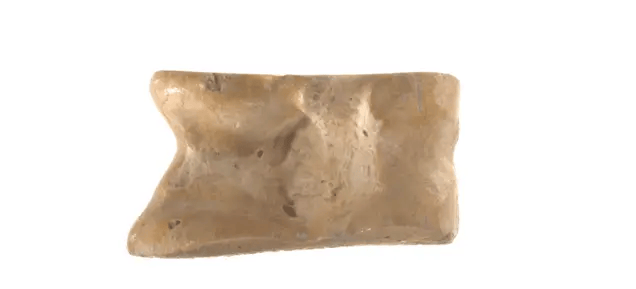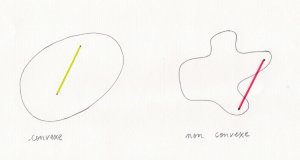3.5 More on this topic
The dice embodies chance, luck and the irrevocability of decisions taken. Its precise origin remains enigmatic, with several ancient civilisations – Indian, Egyptian, Roman and Greek – taking credit for its invention. The ancestors of the dice, made of fruit stones, teeth or stones, appeared around 6000 BC and were generally only two-sided (MacDonald, 2018).
Notable precursors include “astragals”, ossicles taken from the ankles of animals such as sheep and goats. These six-sided objects were used in games of skill and chance in the ancient Greek and Roman worlds. The Omilla game, which was particularly popular, consisted of throwing these astragals into a circle to expel the opponents’ figurines – a practice that continues today in the form of the game of marbles played by children in playgrounds (Hennewig, 2022).

When used as dice, astragals had a particularity: despite having six sides like modern dice, their probabilities were not equivalent. Two sides, because of their configuration, could not be used as a bearing surface, while the other four, all different, offered varying probabilities of appearing during a throw.
Until the Renaissance, the equiprobability of results was not considered important. The concepts of chance and probability did not yet exist, and the choice of which face appeared after a throw was attributed to a divine power.
This paradigm changed with the advent of thinkers such as Galileo and Blaise Pascal who, partly through the study of games and dice, developed the theories of chance and probability. These notions quickly became embedded in the collective consciousness, transforming our perception of dice: today, we simply associate them with luck or misfortune, and naturally use regular solids to guarantee a fair distribution of results (Wissenschaft, 2018).
The common six-sided die we regularly play with is, mathematically, a cube. A cube is a regular, convex polyhedron, i.e. a three-dimensional geometric shape (a geometric solid) with plane polygonal faces that meet along line segments called edges. A polyhedron is said to be regular if it is made up of faces that are all identical and regular and if all its vertices are identical. Convexity is a mathematical term that, among other things, excludes the presence of holes. A part C of space (or of the plane) is convex if it satisfies the following property: for any pair of points p and q located on C, the segment joining p to q is entirely contained within C. For example, a ball is convex, but a ring is not (Cantat, 2022).

Source: https://images-archive.math.cnrs.fr/La-Gomboc.html?lang=fr
In mathematics, a regular convex polyhedron is called a Platonic solid. In addition to the cube, there are exactly 4 other Platonic solids: the tetrahedron, the octahedron, the dodecahedron and the icosahedron. These are also called Plato’s five solids.
In the following video made by the youtube channel Numberphile, mathematicians Katie Steckles and James Grime explain why there are only exactly five Platonic solids:
The dice have 6 stable positions on which they can be placed. Stability means that the object remains in the position in which it was placed, even if it is tapped a little. For example, if a bottle is placed vertically, on its bottom, and I tilt it very slightly and release it, then it will return to its initial vertical position by itself and stay there (Cantat, 2022).
Some objects have only one stable balance position, the most emblematic being the tumbler. This egg-shaped toy, weighted at the bottom, is known in its commercial version as the roly-poly toy, which is now somewhat out of fashion.

If you place a tumbler on its head in a perfectly vertical position, it is theoretically in equilibrium: without any external disturbance, it could maintain this position indefinitely. However, this position is unstable – in practice, the slightest disturbance will cause it to tip over and return to its stable position with its feet on the ground. The tumbler therefore has exactly two equilibrium positions: one stable, the other unstable.
This characteristic behaviour is achieved thanks to a lead ball inserted into the lower part of the toy, positioning the centre of gravity at the bottom of the body. The tumbling toy’s body is therefore not homogeneous: its internal density varies from one area to another to favour a single stable equilibrium position.
In 1995, the Russian mathematician Vladimir Igorevich Arnold asked the following question.
Arnold’s question. Is there a homogeneous convex body with only two equilibrium positions, one stable, the other unstable?
The question asks: can we create a solid similar to the roly-poly toy but made of a perfectly homogeneous material? In 2006, two Hungarian researchers succeeded in doing what seemed impossible, providing a positive answer to Arnold’s question. Gábor Domokos and Péter Várkonyi, mathematicians from Budapest, designed an entirely homogeneous rocking chair that they named “gömböc”. In the following video, Domokos recounts the complex path that led to this remarkable invention.
Chandler Davis, editor of The Mathematical Intelligencer, had this to say about the discovery of the gömböc:
A shape whose impossibility might have been an elegant theorem, but whose existence may be much more elegant.
The Gömböc is a solid in dimension 3. Mathematicians have naturally wondered whether such a body also exists in dimension 2. The answer is no.
Theorem. There is no such thing as a planar gömböc. A convex part of the plane cannot have exactly two equilibrium positions, one stable and one unstable: it always has more!
For a proof of the theorem, we refer the reader to the article (Cantat, 2022).
Polyhedra belong to a branch of mathematics known as discrete geometry, a mathematical field that studies “discrete geometric objects” – i.e. those that can be characterised by a finite number of parameters.
Although this branch is relatively underdeveloped in classical mathematics departments around the world, it occupies a predominant place in computer science departments. This difference in interest can be explained by the twofold attraction it holds for computer scientists: these objects are fascinating in themselves but also offer many practical applications in the computer field.
A common misconception is that discrete geometry is a field without unresolved questions. This perception stems from two main factors: on the one hand, certain fundamental objects such as polyhedra, and particularly the Platonic solids, have been the subject of study since the time of ancient Greek mathematics, suggesting a fully explored field; on the other hand, contemporary problems in discrete geometry often seem excessively technical and inaccessible to non-specialists.
However, contrary to this widespread impression, there are still some open problems in discrete geometry that are remarkably simple to formulate, understandable even without advanced mathematical training, but whose solution continues to challenge researchers. Here are two such open problems.
Unfolding a polyhedron
In this module, we saw that solids have nets, which we cut out, fold along the edges and then glue back together to obtain the original polyhedron. This leads to a very natural question:
Given a polyhedron, can it always be obtained in this way?
In slightly more precise terms, is it always possible to cut a (convex) polyhedron along certain edges, to obtain a connected domain that can be unfolded on the plane (without self-intersection)? Well, we still don’t know (Schlenker, 2009).
Subdividing the cube
Is it possible to subdivide a cube into tetrahedra whose angles are all acute, i.e. strictly less than 90 degrees? In dimension 2, the answer is yes: we can divide a square into acute triangles. In dimension three, well, we don’t know (Schlenker, 2009)!
References
1. Cantat, S. 2022. La Gömböc. Images des Mathématiques. https://images-archive.math.cnrs.fr/La-Gomboc.html?lang=fr
2. MacDonal, J. 2018. The Ancient Origins of Dice. JSTOR Daily. https://daily.jstor.org/the-ancient-origins-of-dice/
3. Schlenker, J-M. 2009. Quelques problèmes ouverts de géométrie élémentaire. Images des Mathématiques. https://images.math.cnrs.fr/billets/10766/
4. Wissenschaft. 2018. Wie Würfel-Würfe wirklich zufällig wurden. https://www.wissenschaft.de/geschichte-archaeologie/wie-wuerfel-wuerfe-wirklich-zufaellig-wurden/
5. Hennewig, L. 2022. „Die Würfel sind gefallen.“ Geschichte und Geschichten eines Spielgeräts und Symbols. Deutsche Digitale Bibliothek. https://www.deutsche-digitale-bibliothek.de/content/blog/die-wuerfel-sind-gefallen-geschichte-und-geschichten-eines-spielgeraets-und-symbols/

